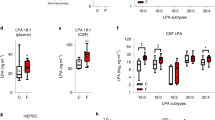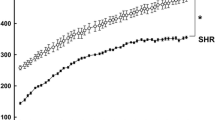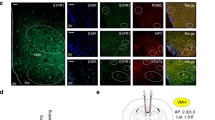Abstract
Hyperphagia was achieved by continuous intracerebroventricular infusion of a melanocortin receptor antagonist (HS024; Neosystem, Strasbourg, France) in rats. The effects of hyperphagia on FA composition and concentration of plasma phospholipids (PL), plasma FFA, and adipose tissue TAG were studied in rats for 8 d [short-term hyperphagia (STH); n=8], or 28 d [longterm hyperphagia (LTH); n=9]. The control rats were treated with artificial cerebrospinal fluid for 8 d (n=8) or 28 d (n=10). The rats were fed the same regular diet. In STH rats the plasma PL and fasting plasma FFA contained higher concentrations of saturated FA (SFA) and monounsaturated FA (MUFA), and plasma FFA contained lower n−6 PUFA than in the control rats. In LTH rats the plasma PL contained higher concentrations of SFA, MUFA, and n−3 PUFA and higher proportions of 16∶1n−7 and 18∶1n−9 at the expense of 18∶2n−6 than in the control rats. In LTH rats the abundant dietary intake of 18∶2n−6 did not enrich 18∶2n−6 of the plasma PL or adipose tissue TAG. In LTH rats the fasting plasma FFA contained more than twofold higher concentrations of SFA and MUFA, and higher proportions of 16∶1n−7 and 18∶1n−9 at the expense of 18∶2n−6 than in the control rats. This animal obesity model shows that LTH affects the FA composition and concentration of plasma PL, plasma FFA, and adipose tissue TAG, a result consistent with changes associated with increased risk of various diseases in humans. These results also demonstrate that LTH alters the FA composition of plasma PL and adipose tissue TAG in a way that does not reflect the FA composition of dietary fat.
Similar content being viewed by others
Abbreviations
- ACSF:
-
artificial cerebrosplinal fluid
- i.c.v.:
-
intracerebroventricular
- LTH:
-
long-term hyperphagia
- MC:
-
melanocortin
- MUFA:
-
total monounsaturated FA
- PL:
-
phospholipid
- SFA:
-
total saturated FA
- STH:
-
short-term hyperphagia
References
Lands, W.E. (1995) Long-Term Fat Intake and Biomarkers, Am. J. Clin. Nutr. 61 (Suppl.), 721S-725S.
Skuladottir, G.V., Gudmundsdottir, S., Olafsson, G.B., Sigurdsson, S.B., Sigfüsson, N., and Axelsson, J. (1995) Plasma Fatty Acids and Lipids in Two Separate, but Genetically Comparable, Icelandic Populations, Lipids 30, 649–655.
Lin, D.S., Connor, W.E., and Spenler, C.W. (1993) Are Dietary Saturated, Monounsaturated, and Polyunsaturated Fatty Acids Deposited to the Same Extent in Adipose Tissue of Rabbits?, Am. J. Clin. Nutr. 58, 174–179.
Holman, R.T., Smythe, L., and Johnson, S. (1979) Effect of Sex and Age on Fatty Acid Composition of Human Serum Lipids, Am. J. Clin. Nutr. 32, 2390–2399.
Schwarz, J.-M., Linfoot, P., Dare, D., and Aghajanian, K. (2003) Hepatic de novo Lipogenesis in Normoinsulinemic and Hyperinsulinemic Subjects Consuming High-Fat, Low-Carbohydrate and Low-Fat, High-Carbohydrate Isoenergetic Diets, Am. J. Clin. Nutr. 77, 43–50.
Hudgins, L.C., Hellerstein, M., Seidman, C., Neese, R., Diakun, J., and Hirsch, J. (1996) Human Fatty Acid Synthesis Is Stimulated by a Eucaloric Low Fat, High Carbohydrate Diet, J. Clin. Invest. 97, 2081–2091.
Acheson, K.J., Schutz, Y., Bessard, T., Anantharanan, K., Flatt, J.P., and Jequier, E. (1988) Glycogen Storage Capacity and de novo Lipogenesis During Massive Carbohydrate Overfeeding in Man, Am. J. Clin. Nutr. 48, 240–247.
Mittendorfer, B., and Sidossis, L.S. (2001) Mechanism for the Increase in Plasma Triacylglycerol Concentrations After Consumption of Short-Term, High-Carbohydrate Diets, Am. J. Clin. Nutr. 73, 892–899.
Austin, M.A. (1999) Epidemiology of Hypertriglyceridemia and Cardiovascular Disease, Am. J. Cardiol. 83, 13F-16F.
Kalderon, B., Mayorek, N., Berry, E., Zevit, N., and Bar-Tana, J. (2000) Fatty Acid Cycling in Fasting Rat, Am. J. Physiol. Endocrinol. Metab. 279, E221-E227.
Coppack, S.W., Patel, J.N., and Lawrence, V.J. (2001) Nutritional Regulation of Lipid Metabolism in Human Adipose Tissue, Exp. Clin. Endocrinol. Diabetes (Suppl. 2), S202-S214.
Yli-Jama, P., Meyer, H.E., Ringstad, J., and Pedersen, J.I. (2002) Serum Free Fatty Acid Pattern and Risk of Myocardial Infarction: A Case-Control Study, J. Intern. Med. 251, 19–28.
Yli-Jama, P., Seljeflot, I., Meyer, H.E., Hjerkinn, E.M., Arnesen, H., and Pedersen, J.I. (2002) Serum Non-esterified Very Long-Chain PUFA Are Associated with Markers of Endothelial Dysfunction. Atherosclerosis 164, 275–281.
Carlsson, M., Wessman, Y., Almgren, P., and Groop, L. (2000) High Levels of Nonesterified Fatty Acids Are Associated with Increased Familial Risk of Cardiovascular Disease, Arterioscler. Thromb. Vasc. Biol. 20, 1588–1594.
Frayn, K.N., Williams, C.M., and Arner, P. (1996) Are Increased Plasma Non-esterified Fatty Acid Concentrations a Risk Marker for Coronary Heart Disease and Other Chronic Diseases? Clin. Sci. (London) 90, 243–253.
Schwartz, M.W., Woods, S.C. Porte, D., Jr., Seeley, R.J., and Baskin, D.G. (2000) Central Nervous System Control of Food Intake, Nature 404, 661–671.
Jonsson, L., Skarphedinsson, J.O., Skuladottir, G.V., Watanobe, H., and Schiöth, H.B. (2002) Food Conversion Is Transiently Affected During 4-Week Chronic Administration of Melanocortin Agonist and Antagonist in Rats, J. Endocrinol. 173, 517–523.
Huszar, D., Lynch, C.A., Fairchild-Huntress, V., Dummore, J.H., Fang, Q., Berkemeier, L.R., Gu, W., Kesterson, R.A., Boston, B.A., Cone, R.D., et al. (1997) Targeted Disruption of the Melanocortin-4 Receptor Results in Obesity in Mice, Cell 88, 131–141.
Jonsson, L., Skarphedinsson, J.O., Skuladottir, G.V., Atlason, P.Th., Eiriksdottir, V.H., Franzson, L., and Schiöth, H.B. (2001) Melanocortin Receptor Agonist Transiently Increases Oxygen Consumption in Rats, NeuroReport 12, 3703–3708.
Skuladottir, G.V., Jonsson, L., Skarphedinsson, J.O., Mutulis, F., Muceniece, R., Raine, A., Mutule, I., Helgason, J., Prusis, P., Wikberg, J.E.S., and Schiöth, H.B. (1999) Long Term Orexigenic Effect of a Novel Melanocortin 4 Receptor Selective Antagonist, Br. J. Pharmacol. 126, 27–34.
Kask, A., Rägo, L., Wikberg, J.E.S., and Schiöth, H.B. (1999) Long-Term Administration of MC4 Receptor Antagonist HS014 Causes Hyperphagia and Obesity in Rats, NeuroReport 10, 707–711.
Sperry, W.M., and Brand, F.C. (1955) The Determination of Total Lipids in Blood Serum, J. Biol. Chem. 213, 69–76.
Nelson, G.J. (1979) Blood Lipids and Lipoproteins: Quantitation, Composition and Metabolism, pp. 10–12, Krieger, Huntington, NY.
Bligh, E.G., and Dyer, W.J. (1959) A Rapid Method of Total Lipid Extraction and Purification, Can. J. Biochem. Physiol. 37, 911–917.
Spayd, R.W., Bruschi, B., Burdick, B.A., Dappen, G.M., Eikenberry, J.N., Esders, T.W., Figueras, J., Goodhue, C.T., LaRossa, D.D., Nelson, R.W., et al. (1978) Multilayer Film Elements for Clinical Analysis: Applications to Representative Chemical Determinations, Clin. Chem. 24, 1343–1350.
Elmquist, J.K. (2001) Hypothalamic Pathways Underlying the Endocrine, Autonomic, and Behavioral Effects of Leptin, Physiol. Behav. 74, 703–708.
van Dijk, G. (2001) The Role of Leptin in the Regulation of Energy Balance and Adiposity, J. Neuroendocrinol. 13, 913–921.
Ma, J., Folsom, A.R., Shahar, E., and Eckfeldt, J.H. (1995) Plasma Fatty Acid Composition as an Indicator of Habitual Dietary Fat Intake in Middle-Aged Adults. The Atherosclerosis Risk in Communities (ARIC) Study Investigators, Am. J. Clin. Nutr. 62, 564–571.
Nikkari, T., Luukkainen, P., Pietinen, P., and Puska, P. (1995) Fatty Acid Composition of Serum Lipid Fractions in Relation to Gender and Quality of Dietary Fat, Ann. Med. 27, 491–498.
Cunnane, S.C., and Anderson, M.J. (1997) The Majority of Dietary Linoleate in Growing Rats Is β-Oxidized or Stored in Visceral Fat. J. Nutr. 127, 146–152.
Marques-Lopes, I., Ansorena, D., Astiasaran, I., Forga, L., and Martínez, J.A. (2001) Postprandial de novo Lipogenesis and Metabolic Changes Induced by a High-Carbohydrate. Low-Fat Meal in Lean and Overweight Men, Am. J. Clin. Nutr. 73, 253–261.
McDevitt, R.M., Bott, S.J., Harding, M., Coward, W.A., Bluck, L.J., and Prentice, A.M. (2001) De novo Lipogenesis During Controlled Overfeeding with Sucrose or Glucose in Lean and Obese Women, Am. J. Clin. Nutr. 74, 737–746.
Hudgins, L.C., Siedman, C.E., Diakum, J., and Hirsch, J. (1998) Human Fatty Acid Synthesis Is Reduced Atter the Substitution of Dietary Starch for Sugar, Am. J. Clin. Nutr. 67, 631–639.
Parks, J.E., Krauss, R.M., Christiansen, M.P., Neese, R.A., and Hellerstein, M.K. (1999) Effects of Low-Fat, High-Carbohydrate Diet on VLDL-Triglyceride Assembly, Production, and Clearance, J. Clin. Invest. 104, 1087–1096.
Skuladóttir, G.V., Gudmudsdottir, E., Olafsdottir, E., Gudmundsson, T.V., Hardarson, T., Kristinsson, A., Asvaldsdottir, H., Snorrason, S.P., and Gudbjarnason, S. (1990) Influence of Dietary Cod Liver Oil on Fatty Acid Composition of Plasma Lipids in Human Male Subjects After Myocardial Infarction, J. Intern. Med. 228, 563–568.
Crofts, J.W., Ogburn, P.L., Johnson, S.B., and Holman, R.T. (1988) Polyunsaturated Fatty Acids of Serum Lipids in Myocardial Infarction, Lipids 23, 539–545.
Miettinen, T.A., Naukkarinen, V., Huttunen, J.K., Mattila, S., and Kumlin, T. (1982) Fatty-Acid Composition of Serum Lipids Predicts Myocardial Infarction, Br. Med. J. 285, 993–996.
Kirkeby, K., Ingvaldsen, P., and Bjerkedal, I. (1972) Fatty Acid Composition of Serum Lipids in Men with Myocardial Infarction. Acta Med Scand. 192, 513–519.
Salomaa, V.V., Salminen, I., Rasi, V., Vahtera, E., Aro, A., and Myllyla, G. (1997) Association of the Fatty Acid Composition of Serum Phospholipids with Hemostatic Factors, Arterioscler. Thromb. Vasc. Biol. 17, 809–813.
Grimsgaard, S., Bønaa, K.H., Jacobsen, B.K., and Bjerve, K.S. (1999) Plasma Saturated and Linoleic Fatty Acids Are Independently Associated with Blood Pressure, Hypertension 34, 478–483.
Gaziano, J.M., Hennekens, C.H., O'Donnell, C.J., Breslow, J.L., and Buring, J.E. (1997) Fasting Triglycerides High Density Lipoprotein, and Risk of Myocardial Infarction, Circulation 96, 2520–2525.
Blades, B., and Garg, A. (1995) Mechanisms of Increase in Plasma Triacylglycerol Concentrations as a Result of High Carbohydrate Intakes in Patients with Non-Insulin-Dependent Diabetes Mellitus, Am. J. Clin. Nutr. 62, 996–1002.
Chen, Y.D., Coulston, A.M., Zhou, M.Y., Hollenbeck, C.B., and Reaven, G.M. (1995) Why Do Low-Fat High-Carbohydrate Diets Accentuate Postprandial Lipemia in Patients with NIDDM? Diabetes Care. 18, 10–16.
Reaven, G.M., Chen, Y.D., Jeppesen, J., Maheux, P., and Krauss, R.M. (1993) Insulin Resistance and Hyperinsulinemia in Individuals with Small, Dense, Low Density Lipoprotein Particles, J. Clin. Invest. 92, 141–146.
Author information
Authors and Affiliations
Corresponding author
About this article
Cite this article
Skuladottir, G.V., Olason, P.I., Jonsson, L. et al. Hyperphagia modifies FA profiles of plasma phospholipids, plasma FFA, and adipose tissue TAG. Lipids 38, 1127–1132 (2003). https://doi.org/10.1007/s11745-003-1170-1
Received:
Revised:
Accepted:
Issue Date:
DOI: https://doi.org/10.1007/s11745-003-1170-1




